

Wolfgang Amadeus Mozart. He composed over 600 works, many acknowledged as pinnacles of symphonic, concertante, chamber, operatic, and choral music.
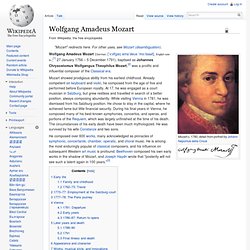
He is among the most enduringly popular of classical composers, and his influence on subsequent Western art music is profound; Beethoven composed his own early works in the shadow of Mozart, and Joseph Haydn wrote that "posterity will not see such a talent again in 100 years. "[3] Early life Family and childhood Anonymous portrait of the child Mozart, possibly by Pietro Antonio Lorenzoni; painted in 1763 on commission from Leopold Mozart Wolfgang Amadeus Mozart was born on 27 January 1756 to Leopold Mozart (1719–1787) and Anna Maria, née Pertl (1720–1778), at 9 Getreidegasse in Salzburg.
Intervall - diatoni och kromatik. Läran om (ton)intervall är viktig, i och med att den bland annat kan vara ett nytt hjälpmedel i samband med musikanalys, ackorduppbyggnad och gehörslära.

Därför följer här en artikel som beskriver de viktigaste aspekterna av intervalläran. Se också Intervallfinnaren. Ett intervall är ett avstånd mellan två toner. Intervall kan beskrivas som: - harmoniska intervall (kallas också samklangsintervall): om två toner klingar samtidigt. - melodiska intervall: om två toner klingar efter varandra. Melodiska intervall kan vara antingen uppåtgående eller nedåtgående: - uppåtgående: om ton nr. 2 är högre än den föregående. - nedåtgående: om ton nr. 2 är lägre än den föregående.
Circle of fifths. Circle of fifths showing major and minor keys.
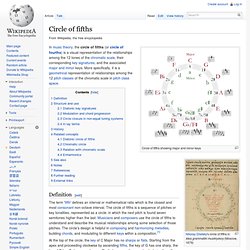
Arab tone system. Quarter tone scale on C ascending and descending.
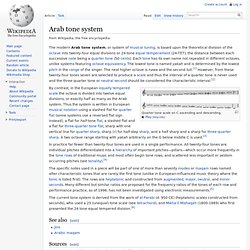
Play In practice far fewer than twenty-four tones are used in a single performance. All twenty-four tones are individual pitches differentiated into a hierarchy of important pitches—pillars—which occur more frequently in the tone rows of traditional music and most often begin tone rows, and scattered less important or seldom occurring pitches (see tonality).[4] The current tone system is derived from the work of al-Farabi (d. 950 CE) (heptatonic scales constructed from seconds), who used a 25 (unequal) tone scale (see tetrachord), and Mikha'il Mishaqah (1800-1889) who first presented the 24 tone equal tempered division.[6] See also[edit] Arabic music. Arabic music or Arab music (Arabic: الموسيقى العربية – ALA-LC: al-mūsīqá al-‘Arabīyah) is the music of the Arab world.
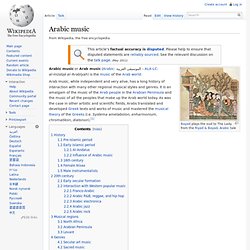
Arab music, while independent and very alive, has a long history of interaction with many other regional musical styles and genres. It is an amalgam of the music of the Arab people in the Arabian Peninsula and the music of all the peoples that make up the Arab world today. A440 - Pitch Standard 'Normal A' - 440 Hz. Prior to the standardization on 440 Hz, many countries and organizations followed the Austrian government's 1885 recommendation of 435 Hz.
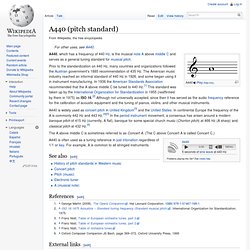
The American music industry reached an informal standard of 440 Hz in 1926, and some began using it in instrument manufacturing. In 1936 the American Standards Association recommended that the A above middle C be tuned to 440 Hz.[1] This standard was taken up by the International Organization for Standardization in 1955 (reaffirmed by them in 1975) as ISO 16.[2] Although not universally accepted, since then it has served as the audio frequency reference for the calibration of acoustic equipment and the tuning of pianos, violins, and other musical instruments. A440 is widely used as concert pitch in United Kingdom[3] and the United States. The A above middle C is sometimes referred to as Concert A. Major scale. Major scales C major scale ) Structure[edit] The pattern of whole and half steps characteristic of a major scale whole, whole, half, whole, whole, whole, half.

Parallelltonart. Parallelltonart är en tonart i dur/moll-systemet som använder samma tonförråd som en annan tonart.
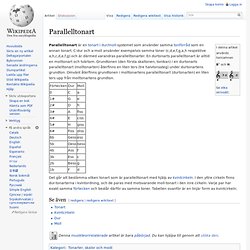
Chromatic scale. Chromatic scale drawn as a circle: each note is equidistant from its neighbors, separated by a semitone of the same size.
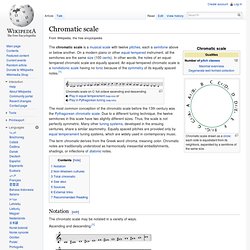
The most common conception of the chromatic scale before the 13th century was the Pythagorean chromatic scale. Due to a different tuning technique, the twelve semitones in this scale have two slightly different sizes. Diatonic scale. The seven-note Diatonic scale is the most important scale used in pop, jazz, country, rock, and classical music.

It is more commonly known as the major scale. This section describes the this scale and other musical concepts associated, including modes, chords, and intervals. Cromatic and diatonic tonalities. In a 12-note approximately equally divided scale, any interval can be defined in terms of an appropriate number of semitones (e.g. a whole tone or major second is 2 semitones wide, a major third 4 semitones, and a perfect fifth 7 semitones.
In twelve-tone equal temperament all semitones are equal in size (100 cents). In other tuning systems, "semitone" refers to a family of intervals that may vary both in size and name. In Pythagorean tuning, seven semitones out of twelve are diatonic, with ratio 256:243 or 90.2 cents (Pythagorean limma), and the other five are chromatic, with ratio 2187:2048 or 113.7 cents (Pythagorean apotome); they differ by the Pythagorean comma of ratio 531441:524288 or 23.5 cents. Minor second[edit] Harmonically, the interval usually occurs as some form of dissonance or a nonchord tone that is not part of the functional harmony.
A harmonic minor second in J.S. Diatonic and chromatic. Melodies may be based on a diatonic scale and maintain its tonal characteristics but contain many accidentals up to all twelve tones of the chromatic scale, such as the opening of Henry Purcell's "Thy Hand, Belinda", Dido and Aeneas (1689) ( Play , Play with figured bass) which features eleven of twelve pitches while chromatically descending by half steps,[1] the missing pitch being sung later. Syntonic temperament. Alternatively put, the syntonic temperament: generates all non-octave intervals from a stack of tempered perfect fifths; andtempers the syntonic comma to unison. Figure 1: The syntonic temperament’s tuning continuum, from (Milne et al. 2007). The syntonic temperament is named after the syntonic comma, as that is the first comma tempered to unison in its comma sequence. Because it has two generators – the octave and tempered perfect fifth (P5) – it is a rank-2 regular temperament.
Because one of its generators is the octave, the terminology of Erv Wilson would describe the syntonic temperament as a linear temperament. Syntonic_Tuning_Continuum.jpg (461×729) Equal temperament. A comparison of some "EDO" equal temperament scales.[1] The graph spans one octave horizontally (open the image to view the full width), and each shaded rectangle is the width of one step in a scale. The just interval ratios are separated in rows by their prime limits. In equal temperament tunings, the generating interval is often found by dividing some larger desired interval, often the octave (ratio 2:1), into a number of smaller equal steps (equal frequency ratios between successive notes). Other equal temperaments divide the octave differently. For example, some music has been written in 19-TET and 31-TET.
Arabic music uses 24-TET as a notational convention. History[edit] The two figures frequently credited with the achievement of exact calculation of equal temperament are Zhu Zaiyu (also romanized as Chu-Tsaiyu. China[edit] Early history[edit] Chromaticism. Chromaticism is almost by definition an alteration of, an interpolation in or deviation from this basic diatonic organization.
Circle of fifths. Pitch (music) In musical notation, the different vertical positions of notes indicate different pitches. Play top & Play bottom. Atonality. The ending of Schoenberg's "George Lieder" Op. 15/1 presents what would be "extraordinary" chord in tonal music, without the harmonic-contrapuntal constraints of tonal music (Forte 1977, 1).
Play More narrowly still, the term is sometimes used to describe music that is neither tonal nor serial, especially the pre-twelve-tone music of the Second Viennese School, principally Alban Berg, Arnold Schoenberg, and Anton Webern (Lansky, Perle, and Headlam 2001). However, "[a]s a categorical label, 'atonal' generally means only that the piece is in the Western tradition and is not 'tonal'" (Rahn 1980, 1), although there are longer periods, e.g., medieval, renaissance, and modern modal musics to which this definition does not apply. "[S]erialism arose partly as a means of organizing more coherently the relations used in the preserial 'free atonal' music. ... Semitone.